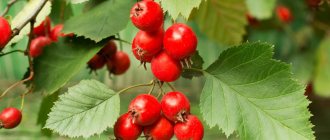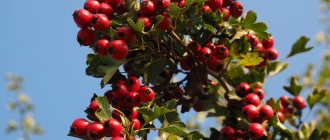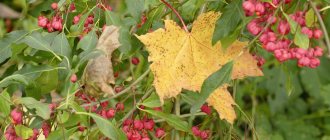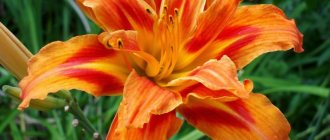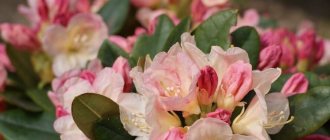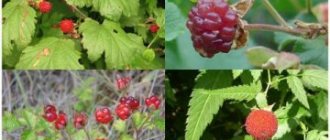In Europe and especially in England, hawthorn hedges are an absolute favorite. A shrub with a uniquely dense crown is truly ideal for creating green fences. But hawthorns also have other advantages. Romantic and spectacular flowering and beautiful fruits will decorate any garden. And the endurance and unpretentiousness of hawthorns still have no equal.
Common hawthorn or prickly hawthorn (Crataegus laevigata). © Kor!An
Hawthorn is a familiar plant that never goes out of fashion.
Hawthorn is a large garden shrub, which in our country is considered completely ordinary and typical. But there is nothing wrong with the fact that the appearance of hawthorns is familiar to everyone and has been used for centuries. After all, it is difficult to find a more reliable candidate for the role of garden decoration, as well as a better plant for creating background and dense plantings.
The scientific name of hawthorn - Crataegus - directly reflects the hardness of its wood (from "krataios" - "strong"). Even the thorns of the hawthorn are so strong that they can pierce almost any shoe, and in the old days they were used instead of nails. Thanks to the most noticeable, species-defining and unique part of this plant in Europe, hawthorn is simply called thorn.
Representatives of the genus Crataegus are deciduous and semi-evergreen shrubs, less often trees with a dense crown. Despite the fact that hawthorns are often pruned, giving them more compact silhouettes or walls, they remain neat and strict even without shaping. In nature, the maximum height of bushes is not limited to 5-7 m, but in the garden, hawthorns are bushes with an average height of 2 - 3 meters, with rare exceptions. Hawthorn is able to surprise with its neat and beautiful crown of a round or cone shape, which is naturally quite dense.
The shoots are purple-red, very beautiful, of varying degrees of pricklyness. The graceful leaves of the hawthorn can be either whole or lobed; they show off a dark green color in the summer, but they have prepared the main show for the fall, when the usual outfit gives way to an orange-red fire.
The spines of hawthorns are modified shoots; at the beginning of development they are small and with tiny leaves, after the loss of which the spines change green color and become more and more durable. In North American species, spines grow up to 5-9 cm, in rare cases - even up to 12 cm; in most European hawthorns they are absent or do not exceed 2-3 cm. The unusually sharp and large spines of hawthorn not only complicate working with the plant , but also require special care when moving near bushes: any shoes for hawthorn thorns are not a barrier.
The flowering period of hawthorns usually occurs in May and June. White or pink flowers are collected in corymbs. Despite the fact that the flowers are small, up to 3 cm in diameter, they sit in dense shields and the bush seems much more lush.
Among the hawthorns there are varieties with double flowers. All hawthorns, without exception, are characterized by beautiful stamens and anthers. Hawthorn blooms profusely and very impressively, before the leaves bloom, but the aroma of the inflorescences is rather unpleasant and repulsive.
After flowering, hawthorns do not always annually produce not only beautiful, but also edible fruits that stay on the branches for more than 2 months. Large, round, pear-shaped or elongated berries of hawthorns are traditionally associated with an orange-red color, but in different species the berries can be purple, black, or yellow. The fruits contain up to 5 triangular hard seeds, and they are located at the top of the fruit. The size of the fruit varies from a few millimeters to almost 3 cm. Hawthorns bear fruit from the age of 8-10 years.
Flowers of the common hawthorn variety 'Crimson Cloud' (Crataegus laevigata 'Crimson Cloud'). © creeksideboulder
Common or prickly hawthorn
This variety is very beautiful during flowering. It is a tree or shrub, sometimes reaching a height of 3-4 meters. The crown of the variety is very dense, with numerous sharp spines, although cultivated forms may lack spines. The leaves of prickly hawthorn are up to 4 cm long, white flowers are collected in corymbs-inflorescences. This species begins to bloom in May. The fruits of prickly hawthorn are too small, round, red, with high taste, and begin to ripen by September. In the wild, this variety grows in Transcarpathia, the Kaliningrad region, Scandinavia, and Western Europe. In small garden plots, a smooth form of prickly hawthorn, reaching a height of 3 meters, is often grown. The plant is winter-hardy and grows well in the middle and southern regions. It is quite shade-tolerant, very drought-resistant, and is not at all picky about soil - it can grow even on rocky soil.
Types and varieties of hawthorns
In nature, hawthorns are very widely represented. The genus Crataegus includes more than a thousand species of shrubs found only in the northern hemisphere, within temperate and partially subtropical climate zones. Among the hawthorns there are both plants that are radically different from each other, as well as strikingly similar and difficult to distinguish species.
To facilitate recognition in landscape design, it is customary to separate Eurasian and North American hawthorns. The former are characterized by deeply lobed leaves and small or absent spines. North American hawthorns have entire or slightly lobed leaves. These are shrubs with very large and strong spines. North American species today are considered more decorative and promising.
The most common type of hawthorn is still the common hawthorn , or prickly hawthorn (Crataegus laevigata). Wind and gas resistant, affordable and very common, it is one of the most versatile garden shrubs. This hawthorn traditionally blooms in May-June. The leaves with 3-5 lobes are bright and glossy, the shoots are prickly. The common hawthorn is characterized by a neat oval crown. The flowers are not only white, but also bright pink; different varieties have different bark layers.
This hawthorn today offers a choice between different varieties and interesting shapes. For example, the variety “Paul Scarlett” with raspberry-pink double flowers is very popular. Decorative forms are even more common - white-pink Bicolor and red Pauli, golden form with yellow fruits and oak-leaved with leaves decorated with round lobes.
Crataegus laevigata 'Paul's Scarlet' flowering
Blood red hawthorn , or bloody hawthorn (Crataegus sanguinea) is a spectacular hawthorn with very beautiful flowering. Its spines are large, up to 4 cm, but they are located very rarely. The flowers are white, with purple anthers. The fruits are blood-red spherical berries drooping on thin stalks. No less than flowering and fruits, this shrub is decorated with brown bark, a few straight spines, and bright leaves flaunting shallow blades.
Hawthorn or semi-soft hawthorn (Crataegus submollis) is one of the best North American species. Orange fruits with very tasty pulp are a pleasant bonus for those who choose this species to grow in their garden. The plant has very thin spines, densely shedding branches, the crown is almost perfectly round in silhouette, amazingly thick. The leaves are bright and whole, turning dazzling red in the fall.
One of the most popular types of hawthorn is crataegus monogyna. This is a large classic species with a height of 2 m, has a very dense crown and can easily tolerate strong formation. The shoots are densely spaced. The bush blooms profusely in May and June. The flowers of this hawthorn are white and pinkish, pink anthers on the stamens give the plant an unusual charm. The fruits are light red and are considered valuable medicinal raw materials. The single-pistillate hawthorn has many decorative forms - pyramidal pink, white terry, white-variegated, thornless, red terry, continuously flowering, crimson, weeping, split-leaved, etc., as well as a number of hybrid varieties.
Blood red hawthorn (Crataegus sanguinea). © travibaikal
Soft hawthorn (Crataegus submollis). © pargipuud
Hawthorn (Crataegus monogyna). © vdberk
Green meat hawthorn (Crataegus chlorosarca) can compete with semi-soft in the density and density of the crown. This is a very beautiful plant with short spines, snow-white flowers and almost black tasty fruits. Gray bark and purple shoots, ovate leaves with shallow lobes and dense inflorescences with dark anthers make this plant stand out from any other hawthorn. This is a highly decorative species with atypical gray-black colors, which always attracts the eye.
Daurian hawthorn (Crataegus dahurica) is a very decorative species with graceful, medium-sized leaves and a compact crown size. Most often it develops in the form of a low tree with gray bark, reddish shoots with medium-sized spines and lanceolate-diamond-shaped, deeply lobed leaves, creating an elegant crown. White flowers with purple anthers look very delicate. Centimeter-long, spherical fruits of bright red color appear already from the age of six.
Universal in its decorative value, suitable for both solo parts and hedges, the original pinnate hawthorn (Crataegus pinnatifida). This is a spectacular spreading shrub with dark gray bark, very sparse thorns and medium-sized pinnately dissected leaves with a bright color. The fruits of the plant are decorated with warts, and the bush itself looks unusually picturesque and elegant.
Leaves and berries of pinnathorn hawthorn
The largest thorns are those of the large-thorned hawthorn , or large-anthered hawthorn (Crataegus macracantha), which makes it an ideal candidate for creating impenetrable hedges. Spines up to 12 cm long and a very dense crown are combined with light bark, shallow-lobed dark leaves, which are famous for their yellow-red autumn color and ability to persist longer than other species. Bright large fruits glow against the background of foliage; they are somewhat dry and less tasty, but very impressive in appearance.
Lavallee hawthorn is also very popular today , in particular, its most popular variety “Carrierei”, which in catalogs is even called a separate variety - Carrieri hawthorn. White-pink May flowering and bright orange-scarlet fruits look extremely impressive.
Among the controversial hybrids is the very popular Morden hawthorn (Crataegus x mordenensis) - a shrub with double flowers that change bright pink to white, and has thornless shoots. This hybrid does not bear fruit, but is considered a beautiful flowering variety.
Flowering hawthorn morden. © Nadiatalent
Of the very large species of hawthorn, it is worth paying attention to the following:
- Wattian's hawthorn (Crataegus wattiana) is a luxurious shrub or tree up to 6-8 m high with a few thorns, bluish foliage and complex shields of white inflorescences, surprising with yellow balls of fruit;
- fan-shaped hawthorn (Crataegus flabellata) - a species with upright growing shoots, large curved spines, ovoid, fan-shaped leaf blades with a serrated edge, snow-white flowers and bright red fruits;
- Douglas hawthorn (Crataegus douglasii) - a species with beautiful dark bark, without thorns, with irregularly lobed dark leaves, white shields of inflorescences and purple-black fruits up to 1 cm in diameter, captivating with its shade tolerance;
- Maksimovich's hawthorn (Crataegus maximowiczii) with gray-brown branches, without thorns, with ovate leaves and large red fruits.
In the southern regions, it is worth paying attention to a species with original foliage that is not winter-hardy enough for the middle zone - pear hawthorn (Crataegus phaenopyrum) - a species with original, viburnum-like leaves, straight five-centimeter spines and red fruits, the diameter of which is slightly more than 0.5 cm.
general description
Hawthorn fruits are edible and have medicinal properties, which are widely used in folk medicine and pharmacology to create tinctures, creams, and other medications. Due to their delicate, sweet aroma, flowers are excellent honey plants that attract large numbers of bees.
The branches are densely studded with large, strong thorns, which, depending on the species, can reach nine centimeters in length. Their strength is so strong that in ancient times the thorns of this bush were used as nails for small carpentry work. The needles of the thorns are sharp, and the skin pierced by them heals very slowly and painfully.
Bloody hawthorn (Crataegus sanguinea)
The culture reaches a height of three meters and has a neat, dense cone-shaped, oval crown. Branches and young shoots have a purple-red hue. The dark green foliage has a solid (less often lobed) shape. In autumn, the foliage acquires fiery red shades, which is especially appreciated in landscape design.
It blooms with small (up to three centimeters long) white, pink flowers, united in small corymbose inflorescences. There are also specimens with double flowers. The period of abundant flowering of the plant occurs in May-June. After flowering, fruits are formed - small berries that, when ripe, acquire a red-orange hue. In some species, the fruits may be yellow, black or even purple. The plant begins to bear fruit at the age of eight.
Semi-soft hawthorn (Crataegus submollis)
The use of hawthorns in ornamental gardening
It is not for nothing that hawthorns have gained a reputation as universal garden shrubs. They are suitable for landscaping large, medium or small areas. Their bushes never look too bulky or, conversely, inconspicuous.
Hawthorns are used as:
- berry bush, a plant with bright, attractive fruits;
- deciduous shrub with a spectacular autumn crown,
- beautiful flowering plant.
Hawthorns are equally good as individual plants or in groups of varying sizes and densities. Plants are grown as shrubs, in tree and standard form.
Hawthorns are used in garden design:
- in impassable hedges of landscape or strict type;
- in the undergrowth and forest edge;
- in the alleys,
- as a background shrub;
- in groups with evergreen and landscape species;
- for curly haircuts and placing accents and introducing strict soloists;
- in the background there are large ridges and flower beds;
- for wind protection, camouflage and creating screens.
Hawthorns attract honey insects to the garden, filling it with the cheerful buzzing of bees. And birds are very fond of this bush: they not only feast on the fruits of the plant, but also happily use it to reliably cover their nests.
Hawthorn is a valuable berry bush. The fruits of the plant are edible in all species, but usually only large, tasty and fleshy fruits of just a few species are considered as medicinal and nutritious. Berries not only decorate the garden, but are also used in cooking. They are harvested as they ripen, from August, but the most delicious harvest can be obtained after the first frost.
Hawthorn hedge. © Upupa Epops
Interesting Facts
- Because of its healing and beneficial properties, magical properties were often attributed to the plant in ancient times; the thorns were attached to the front door to protect against evil spirits;
- the ancient Greeks baked bread with the addition of ground dried hawthorn fruits;
- On the eve of May 1, Englishwomen tied hawthorn branches to poles. In which direction the wind bends the branch, the narrowed one will come from that side. If the branch falls, the girl will not get married. Therefore, they tried to secure the branches well.
- The Buryats decorated the baby's cradle with plant branches to ward off illnesses. For a long and happy family life, the newlyweds wove a wreath.
Different nations have their own legends of the origin of hawthorn:
- in Ancient Rus' they believed that a witch turned a good lady into a hawthorn bush so that her good deeds would never dry up. Therefore, the plant has medicinal properties and bears this name;
- according to eastern legend, Allah helped a weak bird, which could not make a nest for itself due to the attacks of large birds, and created a thorny bush that protected the bird;
- young Greek women wove wreaths from hawthorn, wore them and gave them to the god of marriage and family, Hymen.
In the 14th century, hawthorn was almost destroyed due to unsuccessful medical experiments of healers who tried to treat many diseases with it. Fortunately, they realized in time that the plant’s benefits were limited and did not destroy it.
In the 17th century, Peter the Great officially recognized hawthorn as a medicinal plant and began to grow various varieties that grew in the gardens of the royal palace. Medicines and desserts were prepared from berries and flowers.
Hawthorn spines are so strong and sharp that people used them instead of nails. You should be extremely careful near bushes so that the needles do not pierce your shoes and legs. The wood of a plant that grows into a tree is highly durable. Furniture and souvenirs were made from it. People often use hawthorn bushes as hedges for beauty. This is how they used to protect their homes from thieves.
Sources
- https://www.kladovayalesa.ru/archives/8474
- https://ru.wikipedia.org/wiki/%D0%91%D0%BE%D1%8F%D1%80%D1%8B%D1%88%D0%BD%D0%B8%D0%BA_%D0 %BE%D0%B1%D1%8B%D0%BA%D0%BD%D0%BE%D0%B2%D0%B5%D0%BD%D0%BD%D1%8B%D0%B9
- https://kvetok.ru/rastenie/boyaryshnik
- https://kfh-fruktovyjsad.ru/stati/kustarnik-boyaryshnik-posadka-i-uhod
- https://zen.yandex.ru/media/id/5aee9e41ad0f2291ff29661e/boiaryshniki-vidy-na-liuboi-vkus—sekrety-vyrascivaniia-5d82306b1febd400adcab470
- https://7ogorod.ru/plodovye-kusty/boarysnik.html
- https://lechim-prosto.ru/boyaryshnik-foto.html
- https://rastenievod.com/boyaryshnik.html
- https://AgroGnom.ru/berries/boyaryshnik/boyaryshnik-kolyuchij-obyknovennyj-opisanie-rasteniya-posadka-i-uhod.html
- https://dizaynland.ru/derevya/boyaryshnik
- https://newderevo.ru/listvennye-kustarniki/boyaryshnik-obyknovennyj
- https://cvetoshki.ru/kustarniki/boyary-shnik-opisanie-i-agrotehnika-vy-rashhivaniya.html
- https://AgroGnom.ru/berries/boyaryshnik/boyaryshnik-foto-kak-vyglyadit-vyrashhivanie-i-uhod.html
- https://orhide.ru/?p=6942
- https://travelask.ru/articles/boyaryshnik-narodnyy-lekar
- https://ru.wikipedia.org/wiki/%D0%91%D0%BE%D1%8F%D1%80%D1%8B%D1%88%D0%BD%D0%B8%D0%BA
[collapse]
Conditions required for hawthorns
The reputation of the hawthorn as an unpretentious shrub, which even novice gardeners can grow, has been proven by centuries of practice in garden design in a variety of climatic zones. Hawthorns surprise with their undemanding nature and resistance to adverse conditions and polluted environments.
For hawthorns, it is important to provide sufficient lighting: shading negatively affects both flowering and fruiting of the plant. If hawthorn is grown not for its fruits, but mainly for its dense crown (especially if it is planted to create dense hedges), then the plants can be considered shade-tolerant.
For hawthorns you need to choose high-quality and loose soil. This shrub thrives in both loam and sandy loam, is not afraid of the polluted environment of urban conditions, and tolerates gas pollution well. Fertile, fresh or moist soils are best for hawthorns, but in general the plant survives in almost any conditions, except extreme ones. The soil reaction is preferably alkaline; hawthorn does not like acidic soils.
Why hawthorn does not bear fruit: possible reasons
The main reason for the lack of fruiting in hawthorn is that the tree has not reached the required age. Among others, it should be noted:
- lack of sunlight;
- severe pruning - fruits are formed on the periphery, and not inside the bush.
If the hawthorn blooms but does not bear fruit, you should place water with sugar next to it to attract insects. It will be useful to plant another bush on the site - although the crop does not require pollinators, in their presence it forms more ovaries.
Important! Advice such as cutting the bark to get a harvest as quickly as possible, or otherwise injuring the tree, is best left unattended.
Planting hawthorn
Hawthorns, even in regions with harsh winters, can be planted both in the spring, as soon as the soil warms up, and in the fall, at least a month and a half before the arrival of stable frosts. Hawthorns are recommended to be planted in a permanent place at the age of two, because older plants take root worse, and one-year-old seedlings need more careful care.
Hawthorns are placed at a distance of 1 to 2 m for decorative groups and from 15 to 50 cm for hedges. Single-growing bushes can be placed at a distance of 3 m from neighboring crops, but usually such a distance is left only when growing tree-like forms of hawthorns, which are used as tall tapeworms in large gardens.
Planting holes must be prepared in advance. For this shrub, large planting pits with a depth and width of about 70 cm are prepared. It is better to replace the excavated soil with a special substrate, mixing humus and leaf soil with sand, peat and compost and increasing the alkaline reaction by adding lime. It is better to lay a drainage layer of crushed stone or brick chips at the bottom of the planting holes. Before planting, the planting holes are saturated with water.
Pruning of seedlings is carried out only if the plants are used for hedges. It is carried out in the same way for ordinary hawthorns and when tall or tree-like hawthorns are used, which over time lose their bushy shape and do not produce a large number of shoots. Such plants are planted “on the stump” to stimulate crown thickening: they are cut to a height of 10-15 cm, stimulating the growth of strong skeletal shoots.
Hawthorns are planted using the standard method. Plants are installed so that the root collar remains flush with the soil after the soil shrinks. Planting is completed with abundant watering and mulching of the soil.
Common hawthorn, grown as a short tree. © dobbies
Planting and propagation process
A hawthorn hedge is planted as follows:
- First you need to tension the rope between 2 pegs so that the landing line is level.
- Using a stretched rope, a trench is dug about 0.5 m wide and 0.6 m deep for single-row planting. For two-row planting, the width must be at least 1 m.
- The soil is being prepared. A soil mixture is prepared from turf soil, leaf humus, peat and sand, taken in proportions 2:2:1:1. Lime or dolomite flour is added to the mixture.
- A drainage layer of broken bricks or small stones is laid at the bottom of the trench.
- The seedlings are placed in a dug ditch at a distance of 1 m from each other (for single-row planting) and in a checkerboard pattern - 0.5 m (for double-row planting).
- The trench is filled with soil mixture. In this case, each bush should have a hole for watering.
- The plantings are watered abundantly and covered with a layer of mulch (humus, peat) of about 3 cm.
It is recommended to take hawthorn bushes for hedges no older than 2-3 years. Older plants take root less well, because their root system becomes too deep and branched.
It is enough to simply grow seedlings of this crop yourself. Even an inexperienced amateur gardener can do this. This is done by seeds, layering, grafting and cuttings.
Propagation by seeds is in most cases preferable, since some types of hawthorn cannot be grown any other way. To increase germination, seeds must undergo stratification. Under natural conditions, the seeds overwinter under the snow. With the onset of warm days, they wake up and germinate. Artificial stratification is carried out in the refrigerator, where the seeds are stored at a temperature of +1...+5°C for 2-3 months. Then they are sown either directly into the ground or in a box.
Experienced gardeners collect slightly unripe hawthorn fruits in the fall, soak them in water for 3 days, then remove the remaining pulp using sandpaper or sand and wash them. It is recommended to keep the seed in a solution of potassium nitrate (1%), and then sow it in open ground before winter. In the spring, the seeds will sprout vigorously. Already in the 2nd year, seedlings grow by more than 0.5 m.
Propagation by cuttings is carried out in spring or autumn. To do this, thick roots are dug up from an adult hawthorn bush, the remaining soil is shaken off from them and cut into pieces of 9-10 cm. Then the cuttings are dug in in an inclined position in a greenhouse or greenhouse. No more than 2-3 cm are left above the ground surface. After a year, they can be transplanted to a permanent place.
Vaccination is available to more experienced gardeners. For this, a 2-year-old hawthorn seedling is used, which is grafted onto a rowan tree. To root cuttings, you need to bend the lower branches to the ground in the spring and sprinkle them with earth. The top of the head remains outside. In the fall, the established bush is separated from the mother bush and replanted.
Caring for hawthorns
The need for watering of shrubs is directly determined by the type of plant. Moisture-loving species and varieties must be watered regularly to ensure stable soil moisture. Watering for capricious plants is carried out rarely, but systematically. One watering once a month with deep soaking of the soil is enough, but twice as frequent water procedures in the summer. Drought-resistant hawthorns do not need watering. But several such procedures at the budding stage and after flowering will help the plants produce a more abundant harvest.
Hawthorns are content with minimal feeding. For these shrubs, it is enough to carry out one fertilizing in early spring to provide the plant with all the necessary nutrients. For hawthorn, complete mineral fertilizers are used in the amount of 100-120 g per square meter of planting. At the beginning of summer, the plant can be additionally fed with any organic fertilizer. If hawthorn is grown for the sake of the most abundant harvest possible, then it is better to carry out three feedings - with full mineral fertilizers in the spring, with potassium-phosphorus fertilizers - at the beginning of flowering and after the start of fruiting.
Hawthorns do not like compacted soils, so it is better to include regular loosening of the soil in the bush care program. It is usually combined with weeding, carrying out light loosening to a shallow depth (up to 10 cm) throughout the season. High-quality aeration or digging of the soil with a shovel is carried out along the perimeter of the tree trunk once a year - in early spring or autumn. Mulching will help simplify plant care. For hawthorns it is not necessary to use special mulch: even simple soil or peat with a layer of 3-4 cm will do.
Despite their status as a resistant plant, hawthorns can suffer significantly from specific and fruit pests, powdery mildew and rust. Fruit sawflies, mites, scale insects, mealybugs, weevils and other pests of apple, maple and cherry trees are often found on hawthorns. Rust or powdery mildew and various types of spotting are combated with highly specialized fungicides. For pests, it is better to carry out preventive treatments with insecticides simultaneously with fruit plants.
Use in cooking
Hawthorn is widely used for making desserts; marmalade, jam, marmalade, jelly, and candies are made from the fruits. The berries are ground with sugar, frozen fresh, and juices are made, which are diluted with water or added to cocktails. Berry sauces for meat and pancakes are very tasty; dried hawthorn is ground into flour and added to baked goods for an original taste.
Medicinal use
Since the 16th century, hawthorn has been used in medicine. In former times, it was used only as an astringent for diarrhea and dysentery. Since the 19th century, tea from flowers and leaves began to be used as a blood purifier, and since the beginning of the 20th century, hawthorn fruits and flowers have been recommended as a medicine for diseases of the heart and blood vessels.
Hawthorn tincture
Common hawthorn (Crataegus laevigata (Poir.) DC.), Blood-red hawthorn (Crataegus sanguinea Pall.), Green-fruited hawthorn (Crataegus chlorocarpa Lenne et K.Koch), Daurian hawthorn (Crataegus dahurica Koehne ex CKSchneid.), Hawthorn monopistil ( Crataegus monogyna Jacq.), Crataegus pentagyna Waldst. et Kit. ex Willd. and other species are producing plants for the production of two types of medicinal raw materials: hawthorn flowers (lat. Flores Crataegi) and hawthorn fruits (Fructus Crataegi). Flowers are collected at the beginning of flowering in dry weather, dried under a canopy or in dryers heated to +40 °C. The fruits are harvested at the stage of full ripeness and dried in warm rooms or in dryers at temperatures up to +70 ° C on sieves. The main active ingredients are flavonoids: hyperoside, quercitrin, quercetin, vitexin, acetylvitexin, as well as hydroxycinnamic acids - caffeic and chlorogenic acids.
Medicines made from hawthorn have a cardiotonic effect. They enhance myocardial contractions, but reduce its excitability; triterpene acids increase blood circulation in the coronary and cerebral vessels, increase the sensitivity of the heart muscle to the action of cardiac glycosides, and eliminate pain and discomfort in the heart area. Hawthorn preparations are used in complex therapy of functional disorders of the heart, cardialgia, menopausal syndrome, hypertension, astheno-neurotic conditions [9]. In scientific medicine, alcohol tincture is used, as well as liquid and thick extracts from flowers and fruits. In folk medicine, hawthorn flowers are used for the same purposes (less often fruits, and even more so for nutritional purposes).
Pruning and shaping hawthorn
This shrub perfectly tolerates any forming and is considered one of the “dense” shrubs for any hedges - both landscape and formal. The ability for enhanced shoot formation allows you to change the shape and control the size of hawthorns as you wish.
There is only one mandatory pruning for hawthorns - sanitary cleaning. In the spring, damaged, dry, unproductive shoots are removed from the plant, like any other shrub.
Formation is carried out depending on the desired shape and contours: both to create a strict silhouette and for a hedge, shoots can be cut to 1/3 of their length. In hedges, initial shaping is carried out: the next year after planting, the shoots stimulated by strong pruning are removed, leaving the two strongest ones. Subsequently, the shoots are intertwined and cut to the desired shape.
Young hawthorn seedlings for planting hedges. © digdelve
Wintering hawthorns
Most types of hawthorns are winter-hardy plants that do not need winter protection. It is advisable to provide decorative varieties and forms of any hawthorn with light shelter for the winter, protecting the roots that are prone to protrusion and are located high. A high mulching layer of dry leaves up to 10 cm high is suitable as a protective layer. Species hawthorns, with the exception of low-winter-hardy southern species, will not need shelter. In prickly hawthorn, flower buds and shoots often freeze, but the plant recovers well.
Botanical certificate
Meticulous botanists have long counted and maximally described about 1250 taxa - this is exactly how many species the genus Hawthorn (Crataegus) has. For the most part they are distributed in temperate, less often subtropical regions of the Northern Hemisphere. These are slow-growing, durable, living up to 200-300 years, small trees or large shrubs, often with sharp large or small spines, dense branching and arrangement of leaves, large corymbose inflorescences of white, pink flowers and edible apple-shaped fruits in most species.
Let's get acquainted with the most unpretentious species.
Hawthorn propagation
The availability of planting material and low prices for hawthorn seedlings are largely explained by the ease of their propagation. The more striking characteristics a variety has, the larger the flowers and berries it produces, the more expensive the cost of planting material. Independent propagation of hawthorn requires patience, because the plants bear fruit only after eight years of age, but it is not too complicated in its methods.
The easiest way to get a new generation of hawthorns is vegetative. Layers of hawthorns take root well. It is enough to hill up the base of the bushes or fix individual branches in the soil and regularly water the plants to speed up rooting, and the next year you can plant independent plants.
Other methods are also used for reproduction.:
- separation of root suckers;
- rooting of root cuttings (a root about 2 cm thick is divided into fragments about 10 cm long and rooted like ordinary cuttings - buried 7-8 cm into the soil and maintaining high humidity using a cover-cap);
- grafting of varietal plants and ornamental forms onto rootstocks of hardy hawthorns (for example, common, thorny and monopistillate).
Growing from seeds is not difficult, but the process of growing plants is very long. It will take up to 2 years for the plant to sprout, and the stratification period for different types of hawthorns ranges from 6 to 12 months. Many of the plant’s seeds are empty; the germination rate is quite low, about 50%. Hawthorn is sown before winter, and for sowing, freshly harvested seeds of unripe fruits are used, in which the shell around the seeds has not yet completely hardened. The fruits are soaked in water for several days, and then rubbed through a sieve and the seeds are washed to remove any remaining pulp. The seeds are pickled during the day in a solution of a growth stimulant or potassium nitrate of one percent concentration.
Sowing of seeds is carried out before winter in large boxes or greenhouses. The seeds of the plant are sown very densely. The crops are covered with soil and a layer of dry leaves on top. In spring, hawthorn seedlings are almost indistinguishable from apple tree seedlings; they are very small. During the first year, the plants grow slowly, reaching a height of only 10 cm only with constant care. To grow them into the beds, they are transplanted the next year. In addition to watering and other care, they begin to carry out formation, cutting off all shoots that have reached a height of 50-60 cm to the level of the second or third bud from the bottom in order to stimulate the growth of lateral branches. During the entire period of growing, the plants are controlled by shortening the main shoots and leaving only 2 side shoots, removing excess shoots and forming the base of the bush from strong branches.
Hawthorn is blood red. Therapeutic effects on the body
Blood-red hawthorn, or Siberian hawthorn (Crataegus sanguinea) is one of the most widely cultivated species. It has been well studied as a medicinal plant. It is a small tree or shrub 2-5 m high with few or no thorns. The leaves are dark green, dull, rough, 3-6 cm long.
Features of cultivation
Winter-hardy, light-loving, prefers soils of average moisture.
Hawthorn flowers and fruits improve blood circulation in the vessels of the heart and brain, act as a vasodilator, and relieve spasms of cerebral vessels. As a result, the supply of oxygen to these organs improves.
Based on this, hawthorn is used for high blood pressure, especially at the initial stage, and it also eliminates dizziness and tinnitus.
Also, plant preparations regulate blood circulation throughout the body and are especially recommended for elderly people with circulatory insufficiency.
Hawthorn is also great for the heart. The plant tones it, normalizes the rhythm, eliminates discomfort in the heart area, shortness of breath, is used to treat functional disorders of the heart, such as cardiovascular failure, angina pectoris, angioneurosis, atrial fibrillation, paroxysmal tachycardia, extrasystole, and fights cardiac neuroses.
The medicinal properties of hawthorn also have a positive effect on the gastrointestinal tract. Plant preparations improve digestion, eliminate flatulence and pain in the intestines, and help normalize stool during diarrhea, including in children. Also, for diarrhea, a decoction of the plant bark is used.
Hawthorn is also used to treat various gastrointestinal diseases. It is also used to treat gastritis of various forms and eliminate diarrhea due to dysentery.
Nervous system
A decoction of hawthorn fruits has proven itself well as a sedative for stress, increased excitability, and also to eliminate the effects of nervous tension.
To treat more severe disorders of the nervous system, as well as when symptoms associated with the cardiovascular system are involved, tincture of the fruit is also used.
Hawthorn is recommended by official medicine for the treatment of increased thyroid function.
For women
Breastfeeding women use hawthorn preparations if there is insufficient milk production. You can often hear the question: can hawthorn be used during pregnancy? There are no direct indications of this in the specialized literature. Therefore, you should not take risks and before you start taking plant preparations, it is better to consult with a doctor whom you trust.
Hawthorn has also proven itself well in home cosmetology. Face masks are made from mashed berries, and an infusion of flowers is used for rubbing. The plant tones the skin, gives it elasticity, normalizes moisture content, and relieves swelling. Cosmetic procedures with hawthorn are especially recommended for women over 30 as a preventive measure for skin aging, as well as during the first age-related changes.
For men
Hawthorn is also useful for men. It is used for the treatment and prevention of prostatitis and prostate adenoma, in preparations for menopause. Fresh berries, jam, decoction (tea) of berries, as well as tincture of flowers are of great benefit for normalizing sexual function and increasing potency.
In addition, hawthorn improves the functioning of the cardiovascular system, which very often suffers in men.
